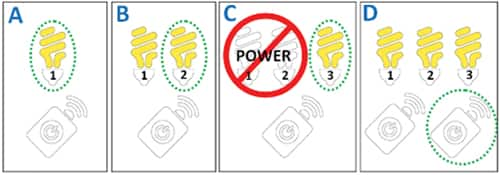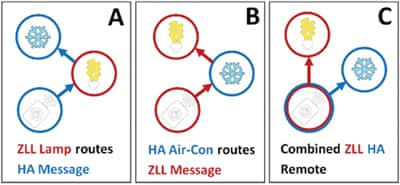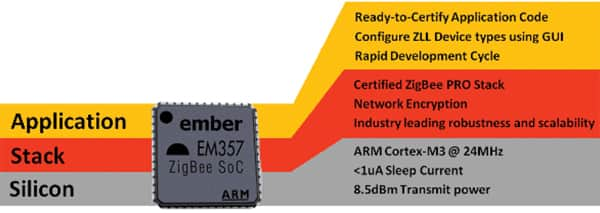Simple and Interoperable Wireless Lighting Control
投稿人:DigiKey
2012-04-19
By implementing a lighting control solution using the ZigBee Light Link (ZLL) standard on the EmberZNet PRO platform, designers can leverage a robust and interoperable network solution to unlock new and exciting consumer-focused lighting applications.
Consumers place a high value on convenience when controlling their appliances, and with the latest advances in color LED technology, the possibilities for choosing and modifying the ambient lighting in the home are greater than ever before. Wireless networking further enables new possibilities for lighting control by making it easier and more cost effective to retrofit modern illumination systems while also making the lighting system’s controllers more convenient to use from anywhere in or around the building.
This emerging wireless lighting control market has until now been served by a range of solutions each with its own particular strengths and weaknesses. One particular problem is that consumers have no simple way to ensure that any individual product will work with another, and therefore it has been extremely difficult for a user to extend their home lighting system incrementally over time. Additionally, some complex commissioning processes required for such networks often means that users struggle to add new devices, even when using products from the same manufacturer. Other solutions may require a high-cost professional installer.
By defining a common standard available to all product designers, the new lighting profile from the ZigBee Alliance addresses both of these issues. Developed in cooperation with major global lighting manufacturers, ZigBee Light Link (ZLL) not only describes an application messaging protocol for advanced lighting control, but it also includes a mechanism which makes out-of-the-box commissioning as simple for the consumer as pushing a button. In addition to these new features, the ZigBee Light Link profile also leverages the key characteristics common to all ZigBee profiles – robust and secure mesh networks based on low-power, low-cost IEEE 802.15.4 radio technology.
Simple device commissioning
As with any new consumer technology, complexity (real or perceived) is a significant barrier to growth. A key principle during the development of the ZLL profile was that the operation of the system be highly intuitive, and certainly no more complex than a traditional wired lighting system. Figure 1 below shows some possible commissioning use cases to demonstrate the ease with which ZigBee Light Link products can be used.

Figure 1: ZigBee light link commissioning.
In (A), the user has a factory-fresh starter kit or similar product. Forming a network with these devices simply entails powering on the lamp, adding batteries to the remote and pushing a button. Powering off the lamp or removing the batteries from the remote has no long-term effect, so once power is reapplied, the network can continue functioning as before.
In case (B), a second lamp can be added to the network, again simply by powering it on and pushing a button on the remote. The new lamp can be from the same manufacturer, or from a different source. Each lamp can be addressed independently by the remote, or alternatively both can be controlled simultaneously using multicast messaging depending on the input from the user.
Case (C) shows how additional devices can be added to the same network, even if one or more of the original lamps is temporarily unpowered (or out of RF range). ZLL networks do not rely on a single coordinator node and therefore there is no single point of failure either for routing messages or when joining additional network devices.
The final image (D) shows firstly that if lamps one and two are powered back on then all four devices will automatically form a single mesh network without any additional user intervention. The picture is also intended to demonstrate how the system allows for additional remote devices on the same network, as well as multiple lamps.
Advanced lighting control features
Unlike other ZigBee profiles such as Home Automation (HA), ZigBee Light Link was designed 100 percent for lighting applications. This allows ZLL products to easily implement different color settings, dimming levels, and brightness; store atmosphere settings; or automate lighting control for maximum convenience and energy efficiency. The extent to which these features are implemented is a choice entirely for the product designer, and systems can be as simple as a single on/off light and switch, or as complex as a fully featured home lighting solution.
These features are all based on the ZigBee cluster library concept which provides a suite of application-level, over-the-air messaging protocols. ZLL incorporates and extends those clusters most appropriate to home lighting applications and uses them to define a range of standard devices on which designers can base real-world products. In this way, a new ZigBee Light Link product can implement advanced features like color controls, color loop, and scene storing/setting quickly and easily, and in a way that operates seamlessly with existing devices on the market.
Assured interoperability
Since the entire system is based on open standards, product designers and consumers can be confident that certified ZigBee Light Link devices will all work together without problems. The first step to ensuring device interoperability is to certify products through the ZigBee Alliance. The best route to trouble-free ZigBee certification is to select a ZigBee-compliant platform on which to base the product. Each of the EmberZNet PRO stack releases is independently certified to guarantee interoperability at the networking level, and a complete list of certified stack platforms from all vendors can be found on the ZigBee Alliance website.
Once a suitable platform has been selected, the next stage is to make sure that the application level features are compliant with the ZLL specification. Here again, Ember provides an off the shelf, certifiable software implementation of the ZigBee Light Link cluster specification to enable designers to quickly and easily deploy lighting solutions. Using the Application Builder tool available from Ember, any standard ZLL device can be configured, and a ready to compile software project can be produced. The only task remaining is to configure the code to interact with the specific product hardware, such as physically turning the light on and off when the appropriate message is received.
One extra benefit of using the ZigBee standard is that ZLL devices are also interoperable on the network level with devices based on other application profiles, such as HA. This allows the end users to integrate different devices in the home, providing a larger and more robust wireless infrastructure within the Connected Home.

Figure 2: Network interoperability.
Figure 2 demonstrates the flexibility of adding devices from different profiles into a single ZigBee network. One possible use case shown in (A) is that the lighting network provides the backbone to the mesh network, since lights are likely to be distributed throughout the home. This would allow devices from other profiles to utilize this network, thus extending the usable range between the two nodes. The reverse case is also possible, where an existing Home Automation network could route messages on behalf of ZigBee Light Link devices – this is shown in (B). Another interesting possibility is a combined remote implementing both profiles. Such a controller is not only able to share the same network, but it is also capable of sending and receiving application messages to/from the different device types. Figure (C) shows the remote as a handheld device, but this could equally be implemented on an Internet enabled gateway, allowing the end user to control their lighting and home automation devices via a PC or smart phone.
Under the hood
From a hardware perspective, competition in the chip vendor market has led to the availability of low cost silicon ideally suited to the demands of lighting control applications. Low sleep current is one key parameter for battery driven devices, but features such as on-chip RF power amplifiers and advanced 32-bit CPUs also mean that cost-effective system-on-chip solutions are now a possibility for the mass consumer market. Because the standard is based on the globally available 2.4 GHz ISM band, manufacturers are able to market ZigBee Light Link products to the widest possible audience. Ember’s EM357 ZigBee System-on-Chip (SoC) is a good example of a ZLL product suitable for many wireless lighting applications.

Figure 3: Ember ZigBee light link platform.
The existing ZigBee PRO networking standard also offers several key benefits to wireless lighting control applications, in addition to those previously mentioned. The existing AES encryption mechanisms designed for M2M applications are well suited to consumer lighting, as they provide protection against both neighboring network traffic and malicious intrusion without adding to the complexity for the end user. Also, since the mesh network is scalable to thousands of nodes, there is almost limitless scope to extend the solution to incorporate a large number of lights, controllers, and sensors into a single integrated system. Finally, many wireless systems suffer from link reliability problems. ZigBee Light Link utilizes the layered acknowledgement and retry mechanisms designed into the ZigBee stack to ensure that application messages are received reliably, and with an acceptable latency.
ZigBee light link summary
The following list outlines the benefits of using the ZigBee Light Link Platform for consumer lighting applications:
- Cost effective and convenient wireless control solution.
- Simple and intuitive installation. No extra tools, no wires, and no specialist knowledge required
- System is expandable incrementally with components of different supporting brands
- Worldwide ecosystem of key lighting manufacturers creates user value
- Reliable, proven networking technology, compatible with devices from other ZigBee profiles
- Supported by wide range of global vendors – low cost, high performance silicon
- Off-the-shelf, certifiable software solutions available

免责声明:各个作者和/或论坛参与者在本网站发表的观点、看法和意见不代表 DigiKey 的观点、看法和意见,也不代表 DigiKey 官方政策。








